Sleeping well after knee replacement is important for healing and pain relief, though discomfort and swelling usually make it difficult. The best way to sleep is to lie on your back with your leg slightly elevated, supported by pillows to keep it straight and relieve pressure on the knee. This position protects the surgical site and helps control swelling, which allows you to rest more easily during recovery.
As recovery advances, side sleeping may work, but you must support the replaced knee and avoid putting pressure on it. Many people use a wedge pillow or extra cushions to stay comfortable and keep proper alignment. Changing sleep habits and adjusting your environment can greatly improve your ability to rest, even when pain or stiffness persists.
Knowing the right sleep positions and simple adjustments helps speed recovery and lessen nighttime discomfort. This article shares practical advice on sleeping comfortably after knee surgery and highlights common mistakes you should avoid.
Key Takeaways
- Sleeping on your back with your leg elevated reduces swelling and protects the knee.
- Supporting the knee is essential when moving to side sleeping.
- Adjusting pillows and your sleep environment increases comfort and sleep quality.
- A supportive and adjustable mattress helps maintain proper leg elevation and comfortable sleep positions after knee replacement surgery.
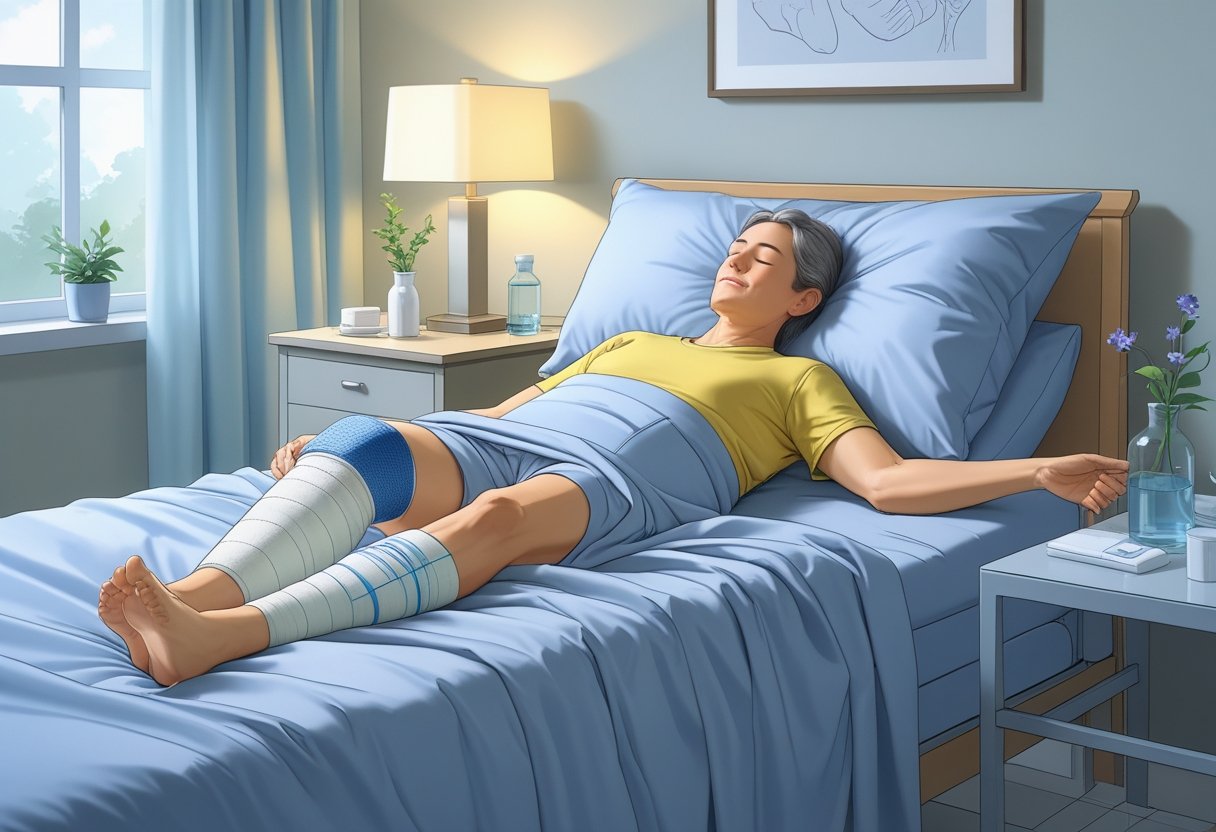
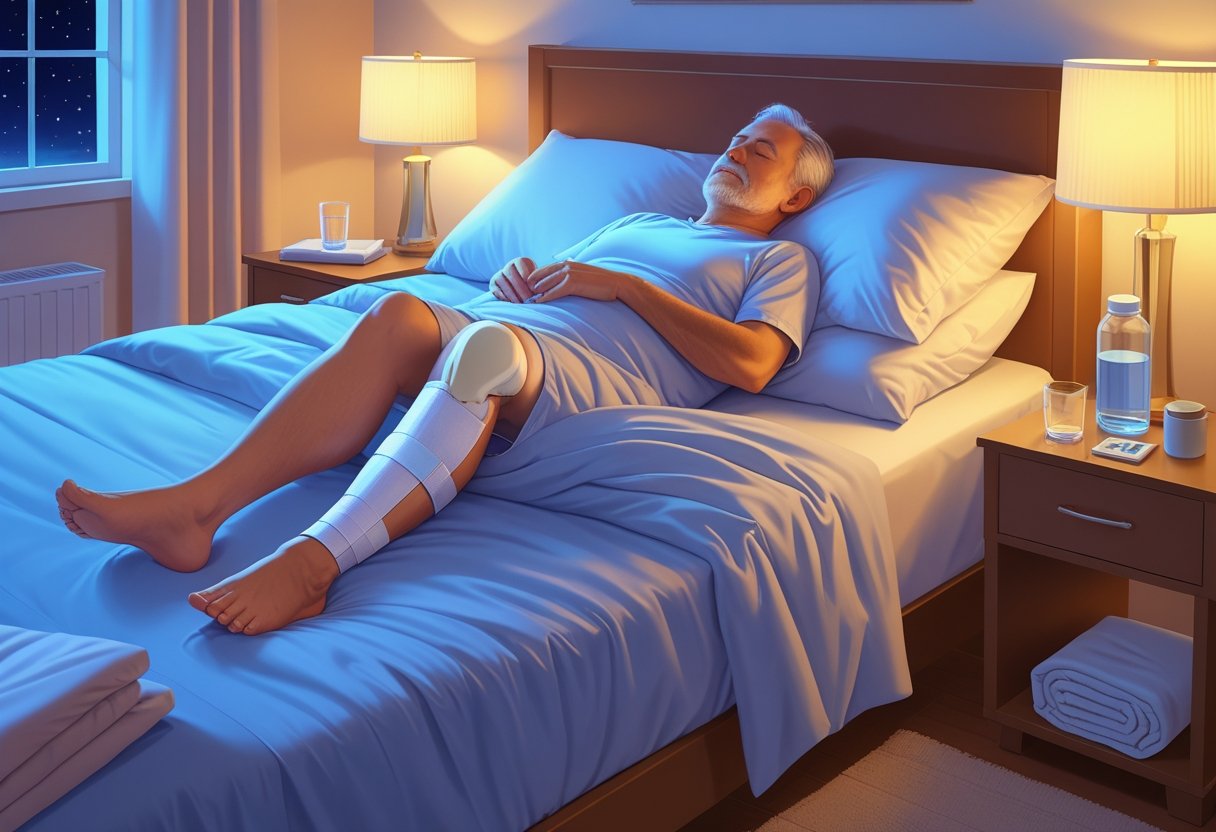
Sleeping well after knee replacement surgery matters greatly for healing and pain management. Good sleep reduces swelling, controls discomfort, and supports physical recovery. Yet many patients struggle to rest because of pain and limited mobility.
Impact of Sleep on Recovery
Quality sleep helps in tissue repair and lowering inflammation after knee surgery. When someone sleeps soundly, the body releases growth hormones that heal the surgical site. Poor sleep raises pain sensitivity, which slows recovery and increases discomfort.
Patients who rest adequately experience better moods and energy levels, helping them engage in physical therapy and daily activities. Maintaining a consistent sleep schedule and finding ways to stay comfortable during the night can directly affect how quickly and effectively one recovers from a knee replacement.
Common Sleep Challenges After Surgery
Many patients have trouble sleeping due to pain, swelling, and stiffness. Nighttime knee pain is common and often causes frequent waking. Limited movement in the knee makes it tough to find a comfortable position. Other factors, like improper use of pain medication or an unsupportive bedroom setup, worsen sleep problems. Swelling can intensify while lying flat, placing extra pressure on the knee. Elevating the leg with pillows and supporting the knee can relieve discomfort and make sleep easier.
Why It’s Hard To Sleep After Knee Replacement
Pain and swelling trigger nighttime discomfort. The new joint may feel stiff and tender, especially when bending or straightening the knee in bed. Muscle soreness from therapy can also interrupt sleep.
Mental stress and anxiety about recovery make falling asleep harder. In some cases, medication side effects or needing to change positions frequently prevent deep rest. Patients should avoid sleeping on the stomach, since it strains the knee.
For practical advice on getting better sleep after knee replacement, checking resources from specialists like Great Lakes Orthopaedics proves helpful. They suggest sleeping on the back with a pillow under the knee and applying ice therapy before bed to reduce swelling and ease pain.
Finding the right sleeping position after knee replacement surgery helps reduce pain and swelling, while it supports faster healing. Proper leg placement and support during sleep remain essential for comfort and recovery. Elevation and pillow support play key roles in managing swelling, whereas certain positions protect the knee and promote better rest.
Sleeping on Your Back: The Optimal Method
Sleeping on your back comes highly recommended after knee replacement surgery. This position keeps the leg straight, which maintains knee extension. Keeping the knee straight proves important since bending too soon or too much might slow recovery or cause discomfort.
Sleeping flat on your back also makes it easier to elevate the leg above heart level, which reduces swelling. However, patients who have back pain or other conditions could find this position uncomfortable. In those cases, small adjustments with pillows or careful side sleeping might work better. Sleeping on your back usually offers the best option until the knee’s strength and flexibility improve.
Elevating the Leg: When and How to Do It
Elevating the surgical leg stays crucial during the first days and weeks after surgery. Raising the leg above heart level reduces swelling and pain since it improves blood flow and limits fluid buildup around the knee.
Patients should elevate the leg during rest or sleep, especially throughout the first week. This does not require constant elevation but rather regular intervals that total several hours each day. As swelling goes down, less frequent elevation suffices.
Elevation works well with pillows or wedge supports placed under the heel or calf. Patients must avoid bending the knee during elevation to prevent stiffness. Following advice from the surgeon or physical therapist on timing and elevation height helps support proper recovery.
Using Pillows and Wedge Supports
Pillows and wedge supports help keep the knee in the right position while sleeping. A common approach uses one to three pillows under the heel or lower leg, which keeps the knee straight and elevated. A wedge pillow provides firmer, more stable support that stops the leg from dropping or bending at night. This also improves comfort and reduces the chance of moving into harmful positions unconsciously.
The goal with pillows involves keeping the leg fully extended and elevated above heart level as much as possible. Proper knee support also eases tension on the incision area. Patients can adjust pillow placement or quantity based on swelling and joint flexibility, while ensuring the position stays safe.
Why No Pillow Under the Knee After Surgery
Placing a pillow directly under the knee joint after surgery is usually discouraged. Although elevating the leg supports recovery, bending the knee increases stiffness and slows healing. A pillow under the knee causes joint flexion, which puts pressure on the incision and surrounding tissues. This may lead to swelling, discomfort, and delays in regaining full knee extension.
Instead, pillows should support the heel or calf to keep the knee straight. Keeping the surgical knee extended promotes better circulation and speeds recovery. Avoiding a pillow under the knee aligns with most post-surgery rehab plans and helps patients regain proper knee movement more efficiently.
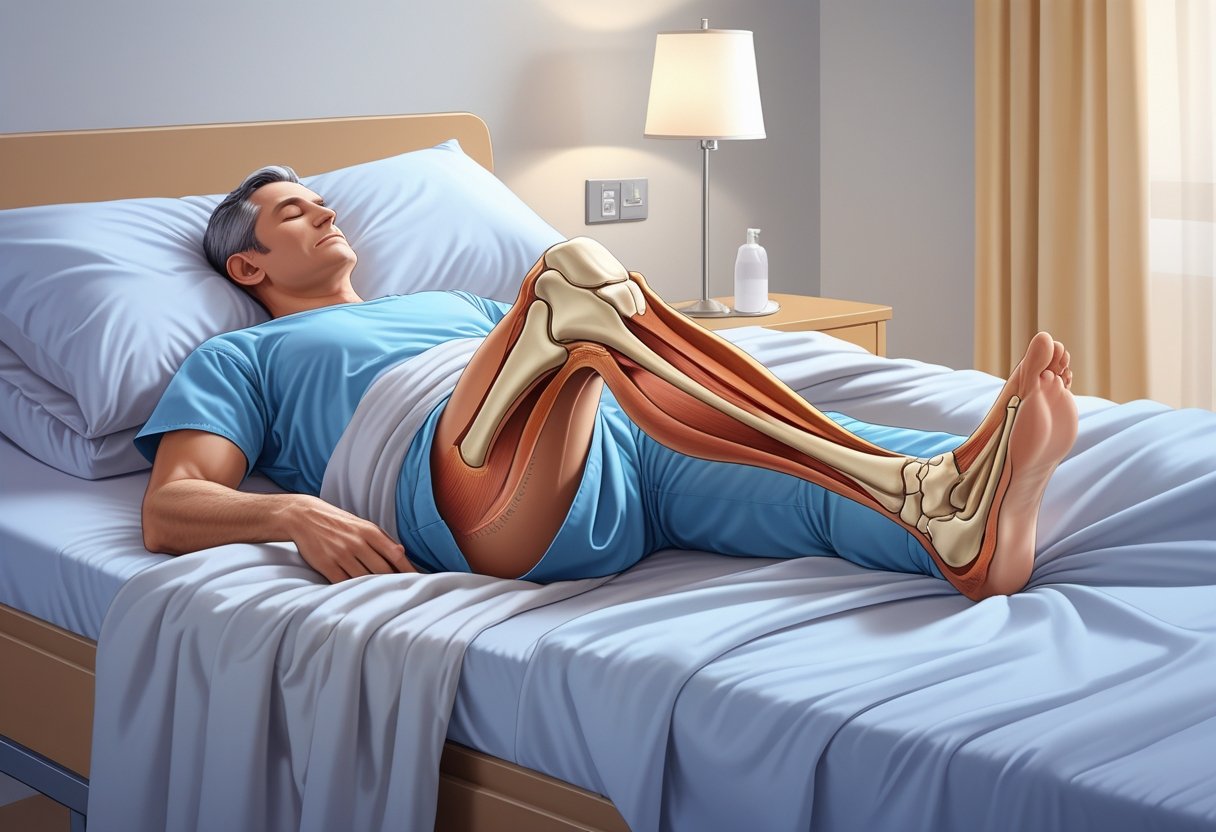
Sleeping on the side is great after knee replacement if done with caution. Proper support and careful movements lower pressure, ease pain, and encourage healing. Attention to pillow placement and body alignment remains essential.
Can You Sleep on Your Side After Knee Replacement
Yes, sleeping on your side after knee replacement surgery is possible. However, the operated leg should stay positioned carefully to avoid stressing the new joint. Keeping the surgical knee facing upward works best. This position reduces pressure on the operated knee and limits swelling. Sleeping on the stomach should be avoided, since it presses on sensitive areas.
Patients ought to wait until pain and swelling subside enough to make side sleeping comfortable. Checking with the surgeon before changing positions ensures safety.
Supporting Your Knee with Pillows
Using pillows to support the knee maintains proper alignment and reduces strain. A firm pillow placed between the knees keeps the legs aligned and prevents crossing, which can create tension. Another pillow behind the back adds stability. Elevating the surgical leg slightly with a pillow under the heel improves blood flow and decreases swelling.
Adjusting pillow placement during the night might be needed to stay comfortable. Pillows also cushion pressure points, helping to prevent discomfort from the bed.
Safely Switching Positions at Night
Changing positions while sleeping on the side requires caution to avoid injury. Sudden movements cause pain or harm the healing knee. He or she should move slowly, using pillows or the mattress edge for support. Rolling onto the back or the non-operated side before shifting helps relieve pressure.
Twisting the knee while moving should be avoided. Maintaining gentle and controlled motions protects the surgical area throughout the night.
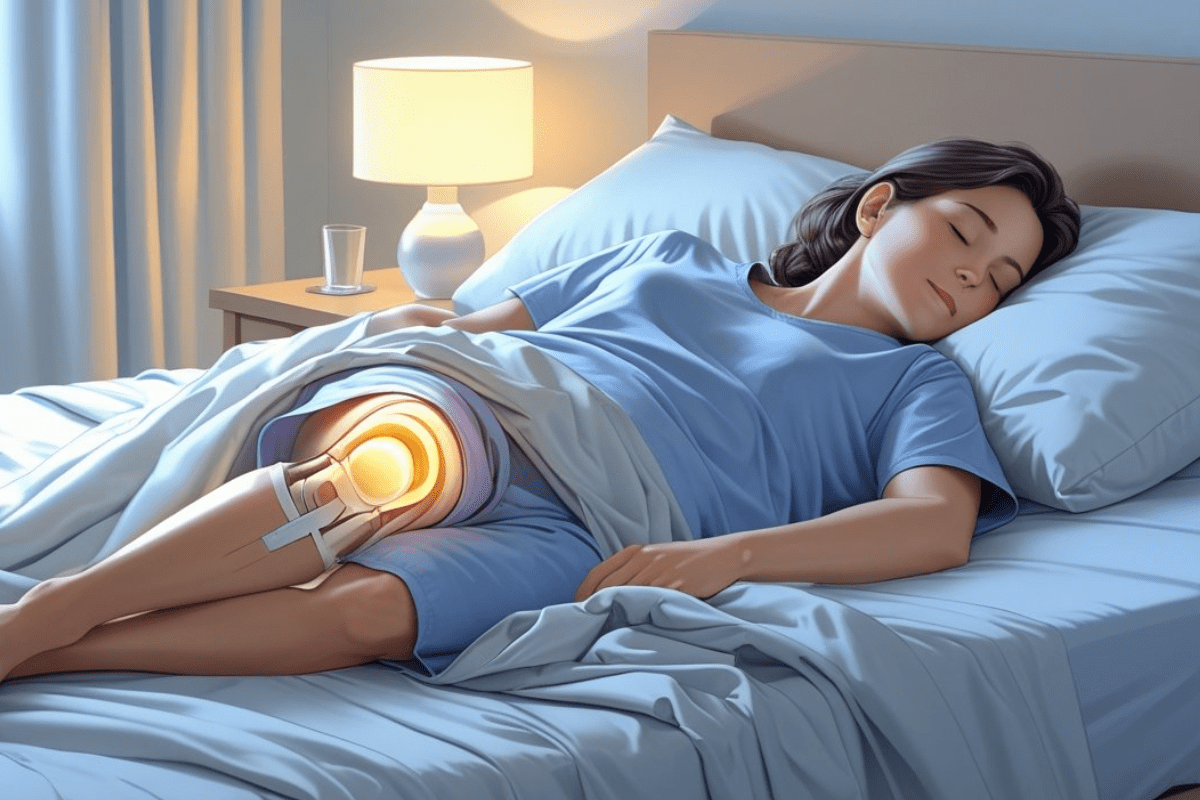
Certain sleeping positions cause pain, swelling, or slow healing after knee replacement surgery. Avoiding these positions protects the new knee joint and supports a smoother recovery.
Risks of Sleeping on Your Stomach
Sleeping on your stomach places pressure on the knee, especially when the leg stays stretched out flat. This position strains the replaced joint and leads to discomfort. It also forces the knee into an unnatural angle, which increases swelling and makes it harder to keep the leg elevated, something essential after surgery.
For those who prefer stomach sleeping, placing a thin pillow under the hips instead of under the knee is better. This keeps the knee from bending excessively and reduces pressure on the joint.
Dangers of Sleeping with a Bent Knee
Keeping the knee sharply bent, such as in a fetal position, restricts blood flow around the healing area. This tight bend causes stiffness and delays tissue recovery. Avoid placing pillows directly under the knee if they force the joint to bend too far. Elevating under the calf or ankle helps, yet too much knee flexion leads to pain.
Patients should keep the knee slightly bent or straight, using pillows to support the leg and reduce strain. This maintains healthy circulation and prevents joint stress during sleep.
Effective pain control plays a major role in helping patients rest well after knee replacement surgery. Managing discomfort with the right methods improves sleep quality and supports healing. Combining medication timing, therapy techniques, and relaxation habits makes nights more comfortable.
Timing Pain Medication for Sleep
Taking pain medicine at the right time reduces night pain and supports uninterrupted sleep. Patients should follow their doctor’s schedule for medications such as acetaminophen, NSAIDs, or prescribed painkillers. Taking pain medication 30 to 60 minutes before bedtime allows the medicine to take effect as they fall asleep. Some patients prefer opioid-free pain relief methods to avoid sleep problems linked to opioid use.
When pain spikes at night, a planned dose before bed prevents waking. Always discuss safe dosages and timing with healthcare providers to avoid overdosing or missing doses.
Using Cold or Heat Therapy
Cold therapy reduces swelling and numbs pain around the knee. Applying an ice pack for 15-20 minutes before sleep eases inflammation and discomfort after surgery. Heat therapy, like warm compresses or heating pads, also relieves muscle stiffness that disrupts rest. Patients should avoid direct heat on swollen areas and use heat only if their doctor recommends it.
Combining cold and heat at different times during the day addresses both swelling and muscle tightness. Using proper wrapping or padding under packs prevents skin injuries.
Relaxation and Bedtime Routines
Relaxation techniques calm the mind and lower pain perception before sleep. Patients can practice deep breathing, meditation, or gentle stretches approved by their doctor to reduce tension. Establishing a consistent bedtime routine signals the body to prepare for rest. Staying away from screens and bright lights an hour before bed helps improve falling asleep.
Comfort remains key: wearing loose clothing, using supportive pillows, and creating a quiet, dark sleep environment prevents unnecessary movements that trigger knee pain.
These habits, along with effective pain management, lead to better overall sleep quality after knee replacement surgery.

Creating the right sleep environment improves comfort and supports healing after knee replacement surgery. This requires careful choices about the mattress, bedding, room lighting, temperature, noise levels, and effective sleep aids. Together, these factors reduce pain and encourage restful sleep.
Choosing a Supportive Mattress and Bedding
A medium-firm mattress gives stable support without putting pressure on the knee. A mattress that feels too soft can cause the body to sink, which leads to misalignment and discomfort. Adding a mattress topper made of memory foam or latex gives gentle cushioning while keeping the knee supported.
Bedding should include pillows that maintain proper leg position. Placing a firm pillow under or between the knees keeps the operated leg aligned and eases strain. Heavy blankets should be avoided since they add weight to the knee. Lightweight, breathable sheets regulate temperature and increase comfort.
Adjusting Room Lighting, Temperature, and Noise
Keeping the bedroom cool, ideally between 60-67°F (15-19°C), helps promote better sleep quality. A cooler room reduces swelling and minimizes discomfort during the night after surgery.
Lighting needs to stay dim or turned off to encourage melatonin production and signal the body to rest. Blackout curtains or a sleep mask block external light sources. Lowering noise levels is critical. White noise machines or earplugs mask disruptive sounds.
Sleep Aids and Products for Post-Surgery Comfort
Applying ice packs before bedtime helps reduce swelling and numbs pain in the knee. Using an ice wrap made for knees allows easy application while lying down. Compression socks improve blood flow and lower leg swelling during sleep. Adjustable beds that elevate the leg also provide relief.
Over-the-counter pain relief should be taken exactly as a doctor prescribes to manage discomfort and increase the chances of falling asleep quickly. Avoiding caffeine or stimulants near bedtime supports natural sleep cycles.
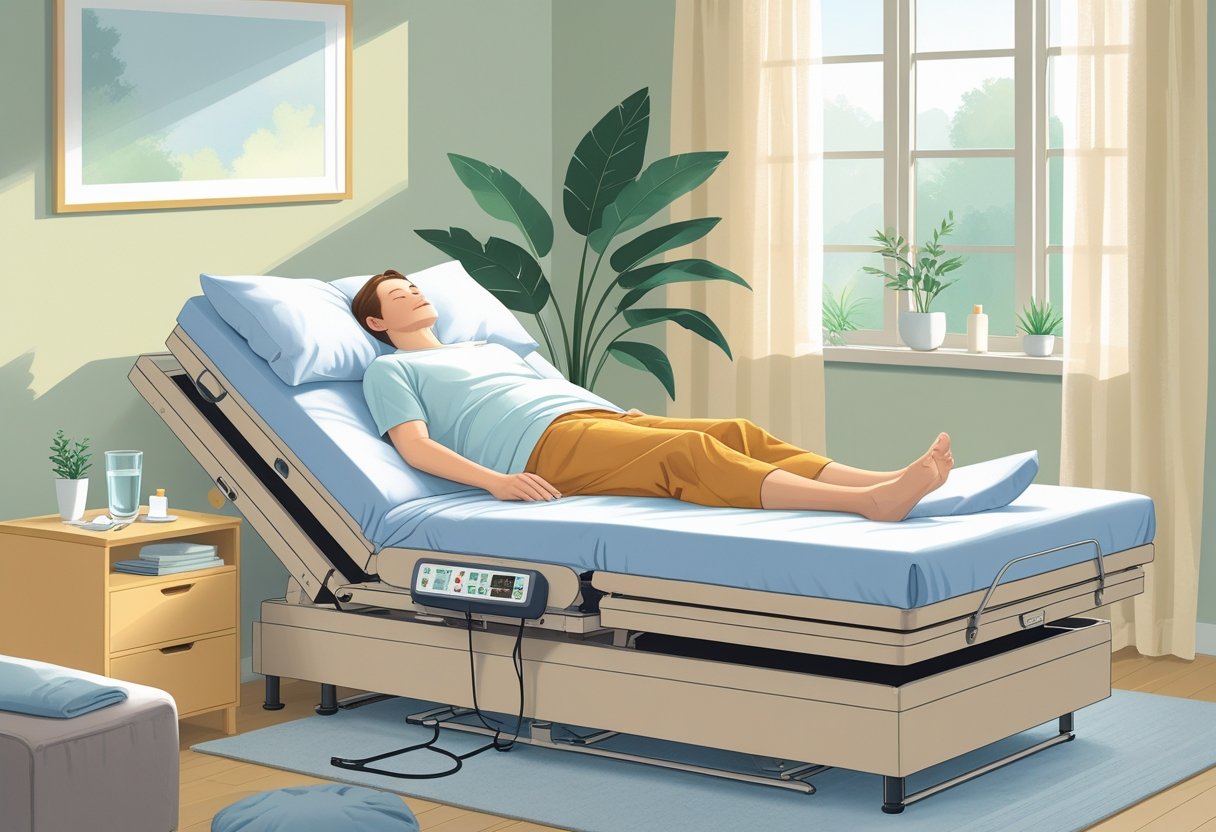
Recovering from knee replacement surgery requires proper support and alignment during rest. Patients should choose a mattress that provides enough support without feeling too hard to help reduce pressure on the knees.
Adjustable beds provide added benefits by allowing elevation of the legs. Elevating the leg helps reduce swelling and improves blood flow. Placing a pillow under the calf and ankle while lying on the back keeps the knee slightly bent and supported.
When considering sleep positions, three options provide comfort and safety:
- Lying on the back with the leg elevated
- Sleeping on the non-operated side with a firm pillow between the knees
- Sleeping on the stomach, if comfortable, with a thin pillow under the hips
Sleeping on the operated side can cause pressure and pain, so it should be avoided. Curling up tightly in a fetal position may strain the knee and is not recommended. Using pillows for support proves helpful. Besides elevating the leg, placing pillows around the body maintains proper alignment and prevents accidental rolling.
Creating a cool, dark, and quiet sleep environment adds to overall comfort. Together, mattress support, proper positioning, and a good sleep setting improve rest quality during knee replacement recovery.
For those considering a mattress with customizable firmness and excellent support, the Saatva Solaire Adjustable Firmness Mattress is a great option. With 50 precise firmness settings on each side, it allows partners to choose their preferred comfort level. The mattress combines a plush Euro-top with natural latex and gel-infused memory foam to provide support while keeping the surface cool throughout the night.
Beyond comfort, the Saatva Solaire Adjustable Firmness Mattress includes free white glove delivery and a 365-night home trial. Its adjustable design suits recovery needs by making it easy to elevate legs or adjust sleeping positions without strain, promoting better circulation and reducing pressure on healing joints.

Frequently Asked Questions
Proper sleeping positions and careful leg support reduce pain and swelling after knee replacement surgery. Patients must avoid placing pressure on the new knee while resting and keep good alignment to support healing. Learning these details improves comfort and speeds up recovery.







